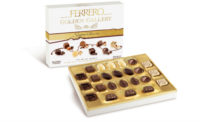Boxed Chocolate
This is not your grandmother’s big box of chocolates; refinement has hit the category, namely in the form of dark chocolate and portion control.
Overview
Ding-dong! It’s 7 p.m. on a Saturday night and
you’re arriving at a dinner party with a chic new box of chocolates
for your hostess in hand. A duplicate box that you purchased for yourself
awaits you at home.
According to industry calculations, it’s not a
growth category of late, but boxed chocolates/gift chocolates are
undergoing a good deal of positive change to attract more of today’s
chocolate consumers and gift-givers. These squared-off/creatively housed
confections are more accurately reflecting confectionery trends with dark
chocolate assortments, sugar-free selections, premium pieces and packaging,
and smaller versions of their former selves, some even purposely
appropriate for a self-gifting daily treat.
Target Audience
There’s no need to completely forsake targeting
consumers buying for Grandma and Auntie on their birthdays and holidays;
chances are they’ll still love the traditional (often larger) boxed
treat of chocolates. And these traditional chocolate-box recipients often
buy the same type of chocolate gift for those on their gift lists. But they
should now be a secondary audience to retailers looking to expand their
business in the category. Today’s primary boxed-chocolate targets are
much younger, hipper and more willing to treat themselves if the
assortment, price and packaging are more upscale and merchandised almost
right in-their-face. (Target’s upscale chocolate brand, Choxie, is a
good example of a chocolate product with a bit of attitude, apparently
targeted to this sort of consumer.)
Self-indulgence is still very much “in”
with the younger-something working professionals. Females in this group are
especially inclined to treat themselves to chocolate on a weekly, even
daily basis, particularly if the (more upscale) packaging and (smaller or
portion-sized) box screams, “You earned this!” And it’s
really okay with them if it costs four times as much as a standard candy
bar. In fact, higher-priced boxed chocolates are typically more attractive
to this target crowd; they translate that to higher quality, affordable
“luxuries.”
Seasonal Opportunities
The boxed chocolates arriving on the market of late go
way beyond heart shapes and Christmas belly-bands. While Valentine’s
Day and the fourth-quarter season are still vital to the category’s
sales, the industry is picking up on other seasonal opportunities such as
Easter, Mother’s Day, Halloween, and even less-popular candy
occasions such as St. Patrick’s Day and Thanksgiving. Mail-order
operations such as Harry & David are notorious for mailing out catalogs
for every holiday and getting customers to think about buying boxed treats
long before the holiday hits. Retailers who dabble a bit in targeting
consumers for ‘odd’ holidays by getting in and getting out with
boxed items, will perhaps start a trend that is more convenient than
mail-order, but just as special.
In addition, savvy vendors are making it easier than
ever for potential gift giving consumers with the inclusion of gift tags as
part of the package.
Outlook
Forget opening Pandora’s Box: Chocolate boxes
will hold more intrigue for today’s consumers. Expect expanded
offerings from boxed chocolate manufacturers in keeping with much-touted
chocolate trends: natural and organic, Artisan lines (even from more
mainstream players), exotic fruit/chocolate combinations, and international
boxed offerings that will familiarize consumers with specific regions of
cocoa bean production. The idea is to allow consumers to “taste
travel.”
$222
million
Gift Box Chocolates Estimated U.S. Retail Market Size
Source: IRI figures for Food, Drug, Mass channels, excluding Wal-Mart
Gift Box Chocolates Estimated U.S. Retail Market Size
Source: IRI figures for Food, Drug, Mass channels, excluding Wal-Mart
Merchandising Musts
• Think outside the big,
old box. Boxed chocolates have moved on to
the next generation and so, too, should a retailer’s display tactics.
A younger, hipper audience should be targeted separately, away from the
staid category in-aisle. Outposts of the more contemporary, smaller boxed
treats can add incremental sales. Taking up less room than the traditional
large boxes, they lend themselves perfectly to cross-merchandising
displays, mentioned below.
• Look up to Starbucks. Take a cue from the retailer who has wisely
merchandised small gift boxes of chocolate alongside its famous java.
Younger audiences are used to this pairing of coffee for me today/boxed
chocolate for me today as well. Outposts of boxed chocolates belong near
coffee, tea stations, the bakery, the deli — anywhere your customers
stop on a daily basis for a hot drink or meal on-the-go. Boxed chocolate is
now considered an on-the-go item for self-consumption.
• Give them a good gift
display. Perhaps the most logical
chocolate-box outpost is anywhere other gifts/gift items might be purchased
— such as near greeting cards and gift wrap, books and calendars, in
the floral department, and the favorite choice of gourmet food retailers
— positioned near red wine.
Retailers that really want to see
profit in the category are making gift baskets available at customer
service or in the floral department, custom-designed with the gift
givers’ choice of wine, boxed chocolate and other selected treats.


